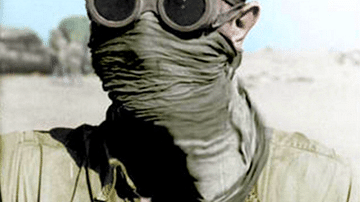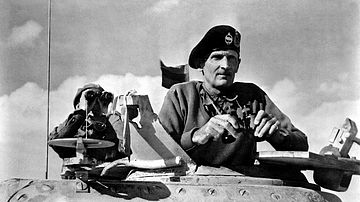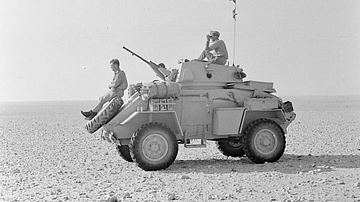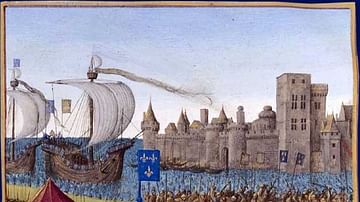
The Desert Rats was the nickname of the 7th Armoured Division of the British Eighth Army, which first fought in North Africa during the Second World War (1939-45). Fighting in the Western Desert Campaigns and the North Africa Campaign, the Desert Rats, so called because of their jerboa shoulder flash, participated in such famous victories as the battles of El Alamein.
Origins & Name
The 7th Armoured Division sprang from the Mobile Division (Egypt), formed in 1938. The division was given excellent training by its commander Major-General Percy Hobart (1885-1957). Hobart had fought in Mesopotamia in the First World War (1914-18), gaining an impressive row of medals for bravery. In the inter-war years, he gained long experience as a tank commander. Hobart also served as a Director of Military Training. A quirky individual who struggled to get on with his peers, Hobart certainly knew what was required for the desert, and it is thanks to his vision that Britain had at least one fighting force that could match the elite of the Axis powers. Hobart's eccentricity and reputation as a flawed genius is revealed by his demise after falling out with the powers that be when the war started, his time spent in the military wilderness as a mere lance corporal in the Home Guard, and then his dramatic rise back to the forefront of generalship when he was given command of whole divisions again, including one of specialised vehicles he himself had developed, used with great success to clear the beaches in the D-Day Normandy landings of 1944.
In a still relatively new concept of mixed arms, Hobart ensured the Mobile Division combined infantry, artillery, and tanks, and it did what its name suggested, emphasising the necessity of movement in modern mechanised warfare. One of Britain's best commanders, Major-General Richard O'Connor (1889-1981), noted in 1939 that the Mobile Division was "the best-trained division I have ever seen" (Liddell Hart, 93).
The Mobile Division earned its 'Desert Rats' nickname from the badge (shoulder flash) its members wore, which showed a jerboa, a small rodent with a long tail, native to the North African desert. Due to the fact that all British and British Empire troops were fighting the same enemy in the same way in the same environment, the name 'Desert Rats' is often applied to any British/British Empire soldier involved in the Desert War in WWII. The extension of the term 'rats' is also evidenced in the nickname 'the Rats of Tobruk' for those Allied soldiers who held out during the siege of Tobruk from April to December 1941.
Structure & Commanders
After war broke out, the Mobile Division was renamed 7th Armoured Division and became part of the Western Desert Force, still based in Egypt but now commanded by O'Connor. Then, from September 1941, as the Western Desert Campaign expanded following Germany's direct involvement, the division was incorporated into the new and much larger British Eighth Army. The Eighth Army was a cosmopolitan force that included troops from across the British Empire, notably New Zealand, Australia, South Africa, Canada, Nepal, and India. There were also Polish, French, and Greek contingents fighting under British command. The Desert Rats, with their long experience of desert conditions, remained "a superbly trained desert-hardened mobile fighting formation…The personal weapons drills, hardiness, discipline, initiative and esprit de corps of the Desert Rats more than compensated for the vast numerical superiority enjoyed by the Italian army" (Lyman, 4-5), its first opponent in WWII.
At its most famous battle at El Alamein against German and Italian forces led by Erwin Rommel, the 7th Armoured Division was part of XIII Corps commanded by Lieutenant-General Brian Horrocks (1895-1985), which was itself part of the British Eighth Army then commanded by Lieutenant-General Bernard Montgomery (1887-1976). At El Alamein, the 7th Armoured Division was composed of the 4th Light Armoured Brigade, the 22nd Armoured Brigade, and the 1st Free French Brigade Group. However, the British high command constantly shuffled around units so that the 7th Armoured Division had "some 17 different armoured regiments and nine infantry battalions under its command at different times" (Moreman, 90).
The 7th Armoured Division was usually more tank-heavy than other units, often having an extra tank brigade. It was realised after bitter experience that the key to using armour successfully was to have sufficient artillery, anti-tank, and infantry back-up, in other words, excellent cooperation between arms and not be dependent on tanks used in concentration which were vulnerable to enemy anti-tank measures.

Notable commanders of the Desert Rats included Major-General William Gott (1897-1942), who was killed when his plane was shot down; General Frank Messervy (1893-1973), who was once captured by the Afrika Korps but, removing his badges of rank, managed to escape after 18 hours; Major-General John Campbell (1894-1942), who innovated the use of small mobile columns but was killed in a car accident in the Halfaya Pass, and Major-General John Harding (1896-1989), whom Montgomery called "that little tiger" (Boatner, 204). Clearly, in the great leveller of the desert, being a commander of the Desert Rats had its hazards.
Campaigns
The Desert Rats were ever-present in the battles that swept across North Africa from 1940 to 1943, campaigns that took place in the deserts of Egypt and Libya and in the more mountainous terrain of Tunisia. It was here that the Allies took on Germany and Italy to control a region that was vital for the protection of Mediterranean shipping routes, important islands like Crete and Malta, the Suez Canal, which linked Britain to the eastern half of its empire, and the oil fields of the Middle East. Later in the war, the Allies prepared North Africa as a launchpad to attack southern Europe through Italy and France.
The Rats fought in such major offensives as Operation Compass (December 1940 to February 1941) which rebuffed the Italian invasion of Egypt. The 7th Armoured Division also fought in both the First Battle of El Alamein (July 1942) and the Second Battle of El Alamein (October to November 1942), which held back and then defeated the Afrika Korps led by Erwin Rommel (1891-1944). Besides these sweet victories, the Rats tasted bitter defeats to Rommel in Operation Battleaxe (June 1941), which attempted to relieve the siege of Tobruk, and again to Rommel in the Battle of Gazala (May to June 1942), after which Tobruk was lost.
Tanks
British tanks in the early years of the desert campaign were often unreliable mechanically, had limited firepower, and inadequate armour. The same could be said of most of the Italian tanks and some of the German ones. British designers had been caught up with the incorrect idea that tanks should fight tanks (Rommel proved time and again that anti-tank guns were far more effective against enemy tanks than tanks themselves). This meant that the 'Cruiser' class of British tanks was designed for high speed and manoeuvrability, but this necessitated compromises in the size of the main gun and the thickness of the armour in order to make the vehicle as light as possible. A heavy tank intended to support infantry was found too cumbersome to be much use in battle conditions. Much had to be learnt the hard way in tank warfare.
The Desert Rats were equipped with inferior Crusader tanks early on in the campaign. The Matilda tank offered good protection from Italian weaponry with its 78-mm armour plating – earning the optimistic nickname 'Queen of the Desert' – but its main 2-pdr gun was hopelessly outclassed by German tank guns, and its range was limited to 40 miles (64 km). Other early and inferior tanks used by the Desert Rats included the light US Stuart tank and the heavier Valentine tank, which was not much of an improvement on its predecessor, the Matilda. The best of the lot, which came later on in the Western Desert Campaign (after the spring of 1942), was the more potent, better-armoured, and highly reliable US-made Grant tank with its main 75mm gun, although this vehicle also had its defects such as a highly visible profile and a limited arc of fire. The Grant tank was slower than its German equivalents, but the addition of a 37mm gun meant that it could attack both tanks and anti-tank gunners, making it a very useful weapon that matched the practical requirements of the war. Not coincidentally, perhaps, when the tide of the campaign turned at El Alamein, the superior M4 Sherman tank (again US-made) was in operation, which had all the advantages of the Grant but with a full rotating turret for the 75mm gun. There was one weakness to the Sherman. Fire was a common problem for all tanks in the war, and there were some horrible deaths as men became trapped in a steel coffin. The Grant, though, had a tendency to simply explode if hit directly in the turret since it was here the designers had seen fit to store its ammunition and fuel.
All of the above tanks were used simultaneously since none were abandoned unless absolutely necessary. Special truck transporters were used to take away tanks which were damaged in battle but might still be serviceable given care and attention at a refurbishment centre. It must be said, however, that the Eighth Army came in for criticism for the low number of tanks recovered post-battle compared to the much more efficient Afrika Korps. Equipment was so precious in the desert, where logistics was a real challenge, that captured enemy tanks (and any other weapons or supplies of use) were frequently put into service by both sides.

Artillery & Anti-Tank Guns
The standard anti-tank gun was the .55in Boyes rifle, but this unpopular weapon lacked punch against any sort of decent armour, was heavy to carry, and had a brutish recoil. The Rats were so dismissive of the Boyes' capabilities that they frequently abandoned them as soon as an enemy equivalent could be captured.
The Eighth Army's artillery units with their high firing rate and accuracy were the arms element most feared by the enemy. The 2-pdr field gun with a 40mm calibre was the most common anti-tank weapon in the first years of the war, although its range and destructive ability left much to be desired as Axis tanks increased their armour plating. From the spring of 1942, the much better 6-pdr with a 57mm calibre was issued. Both of these guns were mounted on wheels and could be towed anywhere they were required.
German units had been quick to use artillery weapons originally designed as anti-aircraft guns for firing horizontally at tanks. Most effective of these adaptations was the Afrika Korps' use of 88mm guns, which could blast away at Allied tanks long before they came close enough to fire themselves. The Eighth Army was remarkably slow to take up this idea but did eventually do so with the 17-pdr gun, which had a 76.2mm calibre. War in the desert required other kinds of improvisation. Mobility became a key factor in success, and so, for example, 2-pdr and even 6-pdr guns were sometimes fitted onto a truck to make a mobile artillery unit. The Boyes anti-tank rifle could be mounted on small armoured vehicles which also had a Bren machine gun. Such light-armoured vehicles were used by the 4th Light Armoured Brigade and very often as part of reconnaissance units.

The 25-pdr was the standard Eighth Army heavy artillery piece and could fire a 25-lb (11.3-kg) shell up to a range of 13,400 yards (12.2 km). The weapon was often let down by the small explosive power of its shells, but it was used to fire against enemy infantry, defensive positions, artillery placements, and tanks.
Small Arms
Special units operated .303 Bren or Vickers machine guns, often fixed to vehicles like jeeps, modern armoured cars like the Bren-gun carrier and Humber, or even WWI veterans like the Rolls-Royce armoured cars still providing sterling service. Machine guns were used in static defences of dug-out pits, sandbags, and camouflage netting. Mortars were mostly the lightweight 2-inch varieties, which could fire rounds accurately up to 300 yards (275 m). The much heavier 3-inch mortar could fire up to 1.5 miles (2.5 km) away. Infantry was also issued with grenades – concussion and phosphorus (to create smoke).
An infantryman's best friend was his rifle, usually a bolt-action Lee-Enfield .303 with a ten-round magazine and fixed bayonet, but sand was its great enemy. Many soldiers wrapped up the breech mechanism of their rifle with a cloth so that sand did not get in and make the weapon useless when it was needed most. Officers and tank crews carried a .38 revolver, and some Rats were issued with a Thompson .45 submachine gun (aka 'Tommy-gun').

Uniforms
In battle, steel helmets painted sand-coloured with grit and mesh added to aid camouflage and break up the outline were worn, replacing the myriad of soft hats various empire troops wore when not in action such as berets, slouch hats, bush hats, turbans, and caps with their stiffeners removed. Most Desert Rats wore khaki shorts and short-sleeved shirts. Footwear was heavy boots or rubber-soled soft suede boots that became so common they were called forever after 'desert boots'. For chilly nights and cool mornings, overcoats and wool sweaters were preferred.
Desert Rat officers "developed an informal outfit in the desert – silk neckerchief, light cord trousers, suede desert boots, and in the cold weather a goatskin coat from Afghanistan or Persia – with home-knitted balaclavas de rigueur for all ranks in the cold early mornings" (Lyman, 20). The 'borrowing' of enemy weapons was extended to uniforms. Italian trousers and boots were a popular acquisition. For all of the above, Desert Rats could be recognised instantly when mixing with other troops, such as in the fleshpots of Cairo and Alexandria.
Desert Warfare
The desert was a peculiar theatre of WWII. Here the battles were intended to destroy the enemy's material and not necessarily to gain territory. There were very few civilians involved outside the coastal areas, only the Senussi nomads who tried to steer clear of these madmen and their highly mechanized warfare. The desert was mostly flat, rock-strewn plains, with the occasional areas with more height such as an escarpment. The southern boundary was blocked to vehicles by such natural features as salt marshes and the great sand dunes of the Sahara Desert. The flat terrain meant fighting was often conducted at a distance, and mobility was essential as armies swept here and there with their commanders, not always successfully, trying to keep track of where everyone was. There was certainly space to manoeuvre as generals dreamt up sweeping troop movements, but the downside was logistics since water, fuel, ammunition, and supplies all had to be transported along with the armies. As one German commander ruefully noted: "the desert was a tactician's paradise, but a quartermaster's nightmare" (Moreman, 9).

There were frequent sandstorms with incredibly fierce winds that could strip paint off a tank. Sand and dust clouds from moving vehicles smothered everybody so that a scarf and superior googles became highly prized additions to standard kit. Surprisingly, perhaps, there were also periods of the year when it rained heavily, and this played havoc with the roads, which, away from the coast, were mere desert tracks and so became boggy vehicle traps. Then there was the local wildlife to contend with, such as scorpions and flies. These conditions helped the Rats form a unique bond as everyone faced two enemies: the Axis army and the desert itself.
Daily life in the WWII Desert Campaigns had its peculiar features. Tea was brewed using empty fuel tins, for example. Waste was criminal. Men used the little water they could spare for shaving to then fill up their vehicle's radiators. Food was usually tinned, like corned beef, sausages, potatoes, jam, and fruit. Dry biscuits were easy to transport. Desert veterans taught the newcomers what was called 'desert sense': the ability to best survive the extremes in temperature, cook and wash without waste, conserve fresh water, attend to the needs of vehicles, navigate using the stars and sharp eyes that picked out meagre landmarks in the seemingly featureless desert, and, above all, to respect the enemy.
After the Desert War
After the Allied victory in North Africa in May 1943, the Desert Rats were deployed in the amphibious invasion of Sicily and then mainland Italy the following summer, in the Normandy landings of 1944, and in the battles towards the Rhine which ended WWII with Allied victory in 1945. The Rats performed well away from the desert, but it is significant that their casualties were unusually high in later campaigns, most likely as a result of these experienced troops being overused and deprived of essential leave.
Desert Rats who never made it home were buried in war cemeteries, which can still be visited today, such as the one at El Alamein, where there is very little else to mark the momentous events which went on there. Those Rats who survived the war perpetuated their unique sense of camaraderie through regular reunions, often including former friends and foes; and their legendary endeavours have been enshrined on celluloid with such classic war films as Desert Rats (1953) starring Richard Burton and Ice Cold in Alex (1958) starring John Mills.







